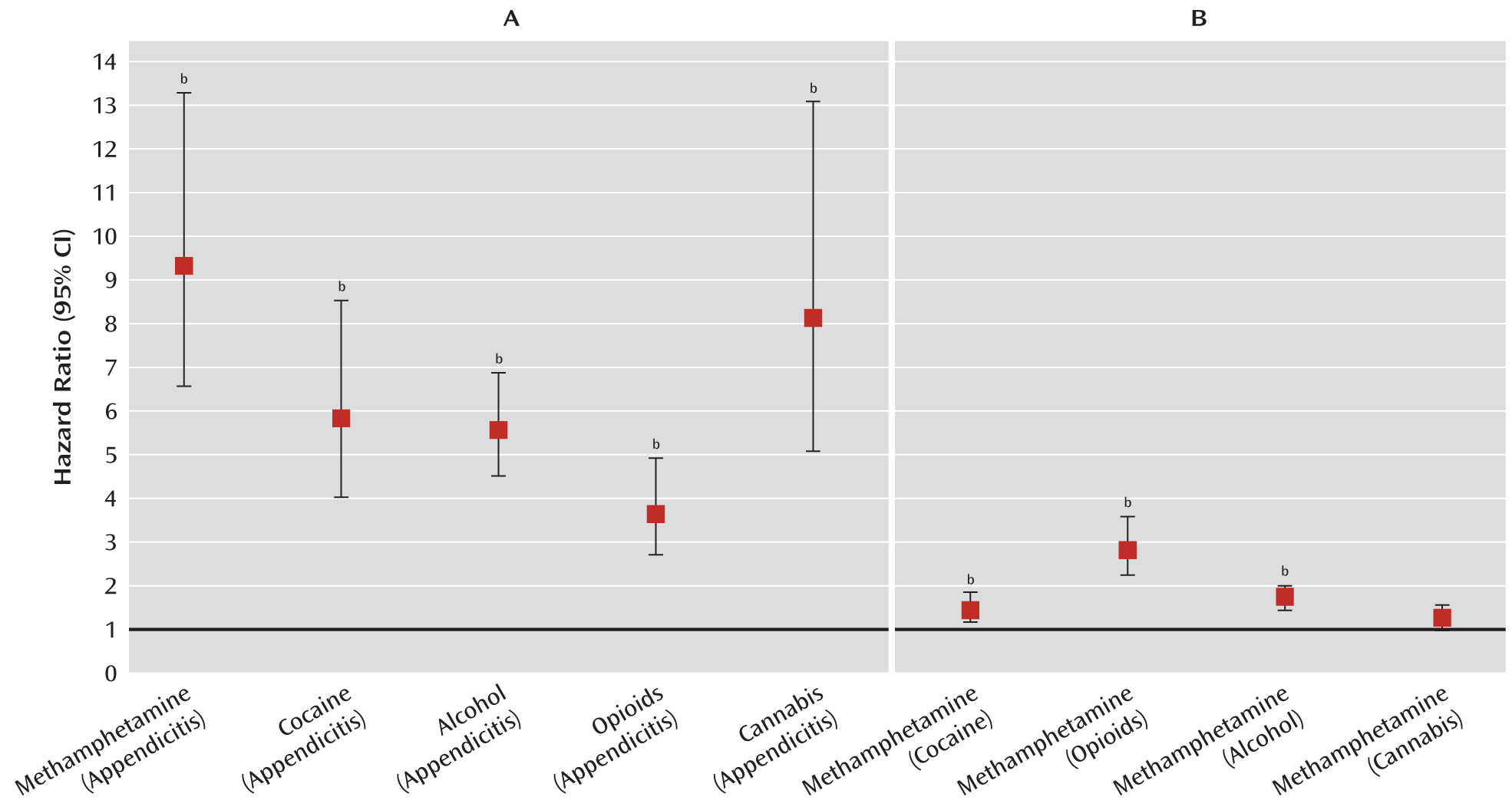Methamphetamine Use and Schizophrenia: A Population-Based Cohort Study in California
Abstract
Objective:
Method:
Results:
Conclusions:
Method
Data
Outcome Measure
Patient Groups
Primary population proxy: appendicitis group.
| Drug Category and ICD-9 Code | Description |
|---|---|
| Alcohol | |
| 303 | Alcohol dependence |
| 305.0 | Alcohol abuse |
| 980.0 | Alcohol (ethyl) poisoning |
| Methamphetamine | |
| 304.4 | Methamphetamine dependence |
| 305.7 | Methamphetamine abuse |
| 969.7 | Methamphetamine poisoning |
| E854.2 | Accidental methamphetamine poisoning |
| Cocaine | |
| 304.2 | Cocaine dependence |
| 305.6 | Cocaine abuse |
| 968.5 | Poisoning by cocaine |
| Opioids | |
| 304.0 | Opioid type dependence |
| 305.5 | Opioid abuse |
| 965.0 | Poisoning by opiates and related narcotics |
| Cannabis | |
| 304.3 | Cannabis dependence |
| 305.2 | Cannabis abuse |
| 969.6 | Poisoning by cannabis (derivatives) |
Secondary population proxy: exclusion criteria group.
Drug cohorts.
Analysis
Propensity score matching and Cox regression.
| Race | |||||||||||||||||
|---|---|---|---|---|---|---|---|---|---|---|---|---|---|---|---|---|---|
| Black | White | Hispanic | Other | Age (Years) | Female | Visitsa | Follow-Up Time (Years)c | ||||||||||
| Group | N | % | N | % | N | % | N | % | Mean | SD | N | % | Mean | SD | Schizophrenia Eventsb | Mean | SD |
| Appendicitis (N=188,732) | 7,384 | 3.9 | 107,375 | 56.9 | 54,050 | 28.6 | 19,923 | 10.6 | 35.5 | 16.2 | 77,969 | 41.3 | 0.51 | 1.5 | 128 | 5.0 | 2.9 |
| Exclusion criteriad (N=10,056,583) | 749,206 | 7.4 | 6,098,589 | 60.6 | 2,193,678 | 21.8 | 1,015,110 | 10.1 | 48.2 | 21.9 | 6,650,615 | 66.1 | 0.63 | 1.5 | 4,545 | 5.1 | 2.9 |
| Methamphetamine (N=42,412) | 1,724 | 4.1 | 31,830 | 75.0 | 6,889 | 16.2 | 1,969 | 4.6 | 30.7 | 9.8 | 24,297 | 57.3 | 1.03 | 2.3 | 425 | 4.8 | 2.5 |
| Cocaine (N=39,390) | 19,777 | 50.2 | 12,664 | 32.2 | 5,524 | 14.0 | 1,425 | 3.6 | 34.3 | 9.6 | 19,321 | 49.1 | 1.92 | 3.5 | 425 | 5.6 | 2.8 |
| Alcohol (N=408,604) | 37,832 | 9.3 | 284,200 | 69.6 | 69,545 | 17.0 | 17,027 | 4.2 | 50.6 | 16.8 | 117,950 | 28.9 | 1.26 | 3.0 | 2,549 | 5.3 | 2.9 |
| Opioids (N=56,844) | 6,670 | 11.7 | 36,168 | 63.6 | 11,873 | 20.9 | 2,133 | 3.8 | 41.8 | 14.4 | 28,624 | 50.4 | 2.05 | 5.2 | 263 | 4.8 | 2.9 |
| Cannabis (N=23,335) | 4,692 | 20.1 | 14,480 | 62.1 | 3,145 | 13.5 | 1,018 | 4.4 | 27.0 | 10.6 | 13,828 | 59.3 | 0.82 | 2.0 | 182 | 3.9 | 2.6 |
Cox regression.
Results
Propensity Score Matching
| Appendicitis Cohort as Matcheda Reference Group | Exclusion Criteria Cohort as Matcheda Reference Group | |||||||||
|---|---|---|---|---|---|---|---|---|---|---|
| Group | Total Nb | Eventsc | Hazard Ratiod | 95% CI | p | Total Nb | Eventsc | Hazard Ratiod | 95% CI | p |
| Appendicitis | 352,024e | 102:83 | 1.23 | 0.93–1.63 | 0.15 | |||||
| Methamphetamine | 72,324 | 324:34 | 9.37 | 6.59–13.32 | <0.001 | 78,474 | 343:20 | 17.49 | 11.15–27.45 | <0.001 |
| Cocaine | 43,752 | 177:31 | 5.84 | 3.99–8.55 | <0.001 | 66,386 | 350:41 | 8.57 | 6.20–11.84 | <0.001 |
| Alcohol | 243,064 | 535:97 | 5.56 | 4.48–6.90 | <0.001 | 722,974 | 2028:313 | 6.47 | 5.75–7.29 | <0.001 |
| Opioids | 90,436 | 180:49 | 3.60 | 2.63–4.94 | <0.001 | 101,480 | 224:51 | 4.32 | 3.19–5.86 | <0.001 |
| Cannabis | 41,670 | 155:19 | 8.16 | 5.08–13.12 | <0.001 | 44,348 | 164:12 | 13.56 | 7.56–24.31 | <0.001 |
| Group (Reference Group)a | Hazard Ratiob | 95% CI | Total Nc | Eventsd | p |
|---|---|---|---|---|---|
| Methamphetamine (cocaine) | 1.46 | 1.15–1.85 | 30,040 | 170:140 | 0.002 |
| Methamphetamine (opioids) | 2.81 | 2.21–3.58 | 49,048 | 252:89 | <0.001 |
| Methamphetamine (alcohol) | 1.68 | 1.41–1.99 | 72,754 | 353:205 | <0.001 |
| Methamphetamine (cannabis) | 1.24 | 0.98–1.56 | 35,756 | 161:129 | 0.073 |
Cox Regression
Matched drug and population proxy cohorts.
Matched methamphetamine and other drug cohort analyses.
Summary of Main Findings

Sensitivity Analyses
Discussion
Comparison With Existing Literature
Strengths and Limitations
Conclusions
Footnotes
Supplementary Material
- View/Download
- 14.94 KB
References
Information & Authors
Information
Published In
History
Authors
Funding Information
Metrics & Citations
Metrics
Citations
Export Citations
If you have the appropriate software installed, you can download article citation data to the citation manager of your choice. Simply select your manager software from the list below and click Download.
For more information or tips please see 'Downloading to a citation manager' in the Help menu.
View Options
View options
PDF/EPUB
View PDF/EPUBLogin options
Already a subscriber? Access your subscription through your login credentials or your institution for full access to this article.
Personal login Institutional Login Open Athens loginNot a subscriber?
PsychiatryOnline subscription options offer access to the DSM-5-TR® library, books, journals, CME, and patient resources. This all-in-one virtual library provides psychiatrists and mental health professionals with key resources for diagnosis, treatment, research, and professional development.
Need more help? PsychiatryOnline Customer Service may be reached by emailing PsychiatryOnline@psych.org or by calling 800-368-5777 (in the U.S.) or 703-907-7322 (outside the U.S.).

